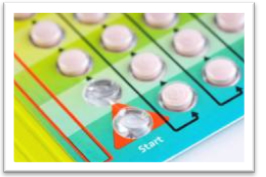The human body is regulated by hormones—chemical messengers produced by the endocrine system. When danger strikes, for example, your adrenal gland sends in the troops: adrenaline. You’re suddenly stronger. Your senses go on high alert. Your breathing and heart rate go into overdrive.
Hormones also regulate reproduction. The pituitary gland sends luteinizing hormones to tell the ovaries to ovulate. As the egg follicle matures, estrogen tells the lining of the uterus to thicken. Progesterone signals the lining to welcome the tiny human embryo. If the egg isn’t fertilized, hormone levels plummet and the lining is shed. If the egg is fertilized and the human embryo implants in the lining, estrogen and progesterone work together to stop further ovulation because the woman is pregnant.
 Hormonal contraception mimics the estrogen-progesterone combo effect to prevent ovulation. What you don’t usually hear from groups like Planned Parenthood is that birth control pills contain synthetic hormones. The human body doesn’t handle synthetic hormones the way it handles natural ones.
Hormonal contraception mimics the estrogen-progesterone combo effect to prevent ovulation. What you don’t usually hear from groups like Planned Parenthood is that birth control pills contain synthetic hormones. The human body doesn’t handle synthetic hormones the way it handles natural ones.
And neither does the environment.
While Life Issues Institute takes no position on contraception, we believe women should know as much as possible about their effects. Environmental worries about synthetic hormones aren’t new. But while Planned Parenthood’s website warns about synthetic chemicals in cosmetics, a search of their site turned up nothing about synthetic hormones in The Pill beyond reference to a 1953 experiment.
Some of what the human body consumes isn’t used and is flushed away, including the synthetic estrogen found in hormonal contraceptives, ethynyl-estradiol (EE2). Scientists around the world are testing wastewater for effects of EE2 on aquatic wildlife. Of course EE2 isn’t the only chemical fish (or people) are exposed to, but it has been identified as the most potent synthetic estrogen in wastewater and is considered an “endocrine disrupter” (hormonal disrupter) and contaminant of growing concern.
EE2 is far more resistant to wastewater treatment than natural estrogen and ends up in rivers and lakes. Studies document the effects of this chemical on aquatic wildlife, even in parts-per-trillion. Scientists noted changes in sex organs of male freshwater fish exposed to EE2. Males looked like females. Ovary tissue turned up in male fish. Mating behavior changed. Some males produced eggs but not sperm. Females produced eggs as always but survival rates decreased. To varying degrees related to exposure, changes led to reproductive failure. In some species, the study population crashed.
Those observations came from one study at the University of Vermont, but many others have documented the same effects since the late 1970s. In November 2012, the European Parliament even considered a proposal to regulate EE2 that would steeply cut pollution levels. Under political, industrial and economic pressure, they voted no.
We looked for input from advocates of hormonal contraception and were not surprised. Birth Control Hormones In Water: Separating Myth From Fact, an editorial in Contraceptive Journal, notes that synthetic estrogen isn’t the only endocrine disrupter or even the only estrogen compound in our water. That’s never been in dispute. But the writers downplay the evidence because it questions contraception:
“Because contraception helps women protect their health and determine the number and spacing of their children, the use of any safe and effective contraceptive method is ultimately good for women, their families, and the environment.”
So a chemical that damages wildlife gets a pass because it prevents a supposed greater danger to the environment—children?
 The idea that humans are the worm in the ecosystem apple isn’t new either. On the fringes, some call for voluntary extinction of humans. But despite EE2’s demonstrated impact on the environment, even mainstream environmentalists routinely promote The Pill to solve what they consider the planet’s biggest problem: too many people. It’s an “end justifies the means” approach.
The idea that humans are the worm in the ecosystem apple isn’t new either. On the fringes, some call for voluntary extinction of humans. But despite EE2’s demonstrated impact on the environment, even mainstream environmentalists routinely promote The Pill to solve what they consider the planet’s biggest problem: too many people. It’s an “end justifies the means” approach.
The hypocrisy is astounding. If the culprit weren’t politically correct contraception, there’d be a total outcry from environmentalist circles. They’d stop hugging trees and embark on a global campaign to eliminate use of the compound. Hard-core environmentalists have never let the welfare of humans get in the way of their agenda.
An episode of our TV program, Facing Life Head-On, exposed the health risks of hormonal contraceptives to women. One of my guests who is pro-abortion is very concerned about the health implications of synthetic hormones for women to the point of being an enthusiastic advocate of natural family planning. Her concern is justified. Just since last summer, Bayer Pharmaceuticals has paid out $1.4 billion—so far—in class action lawsuits over its Yaz, Yasmin and Ocella birth control products. Dr. Willke and I wrote about these health concerns in a previous newsletter.
Hypocrisy by those who promote abortion isn’t new. So-called “pro-choice” activists have turned a deaf ear to millions of Chinese women being brutally tortured by the population police. The issue of the environment versus children is yet another chapter in their book.

Leave a Reply